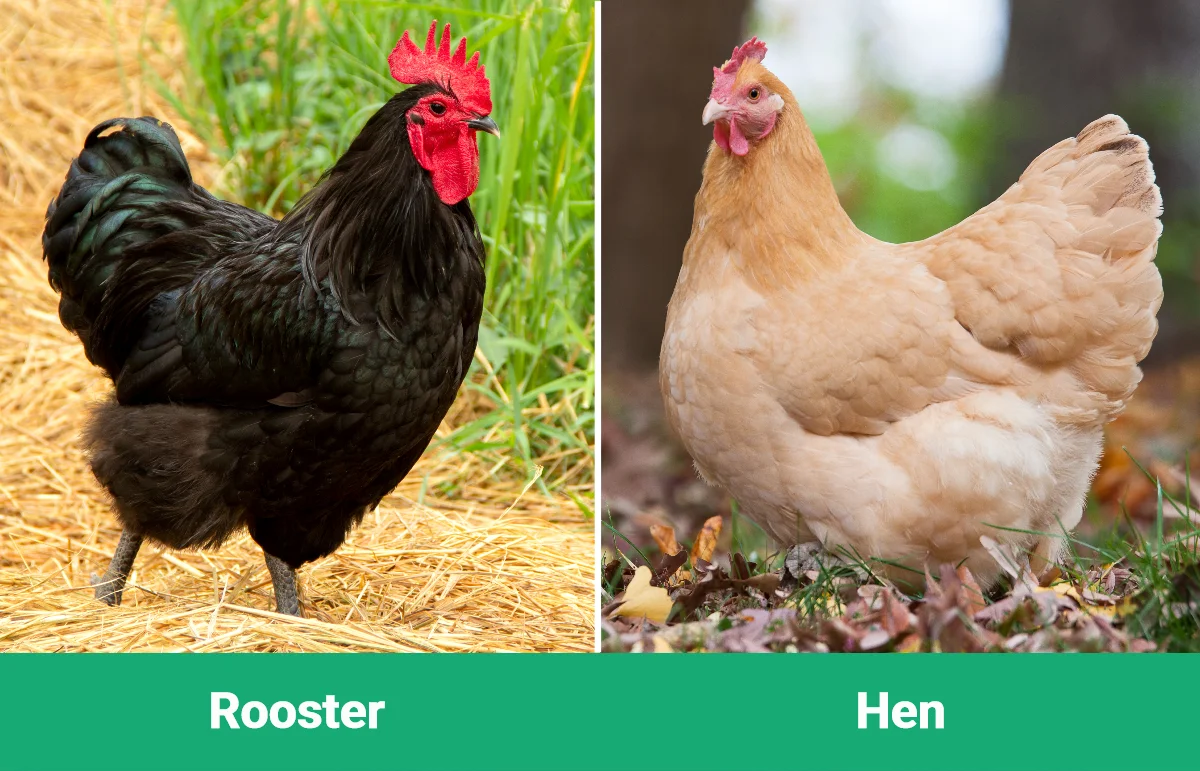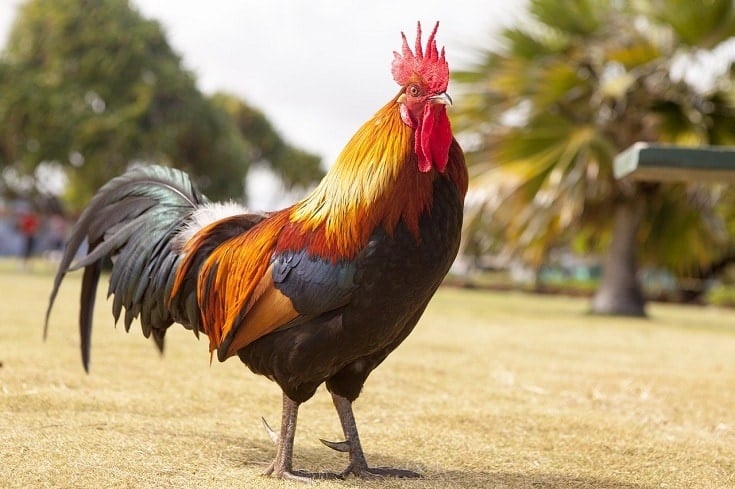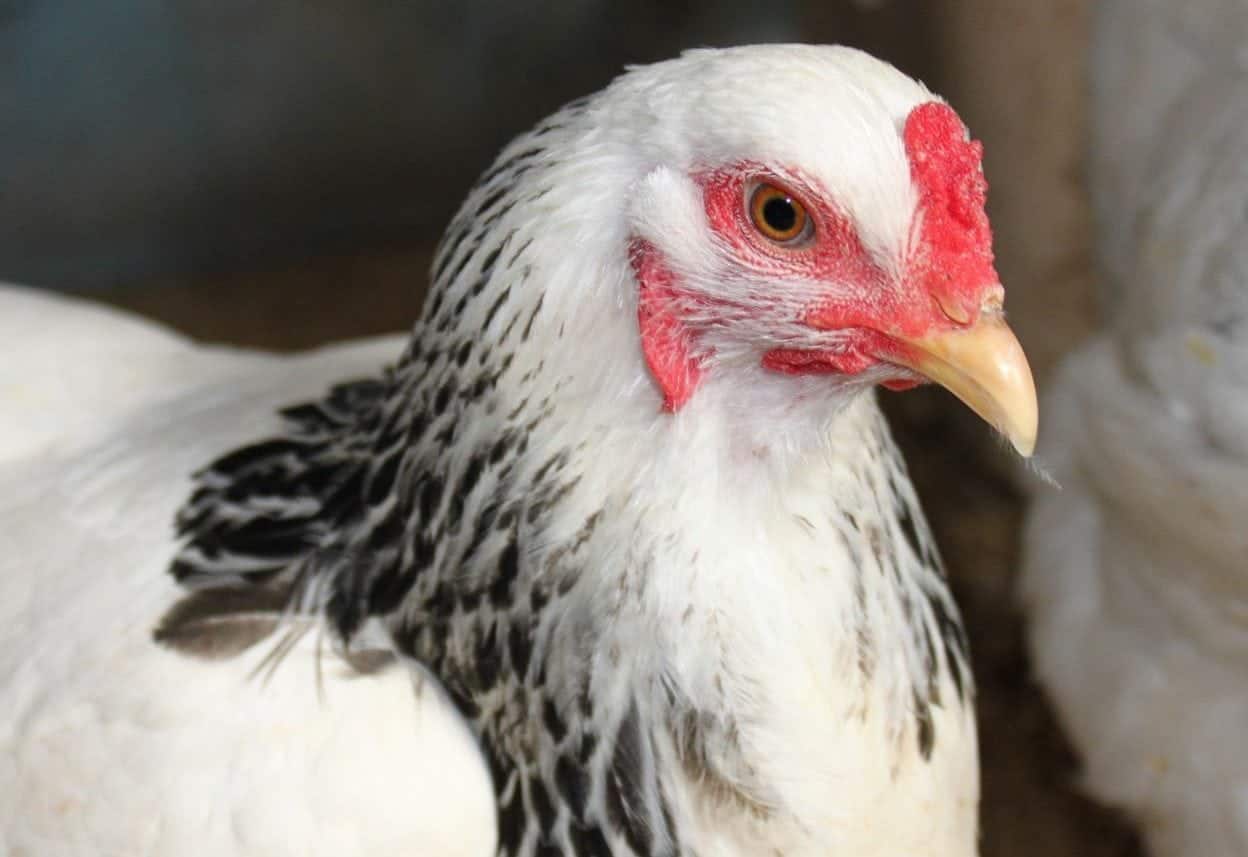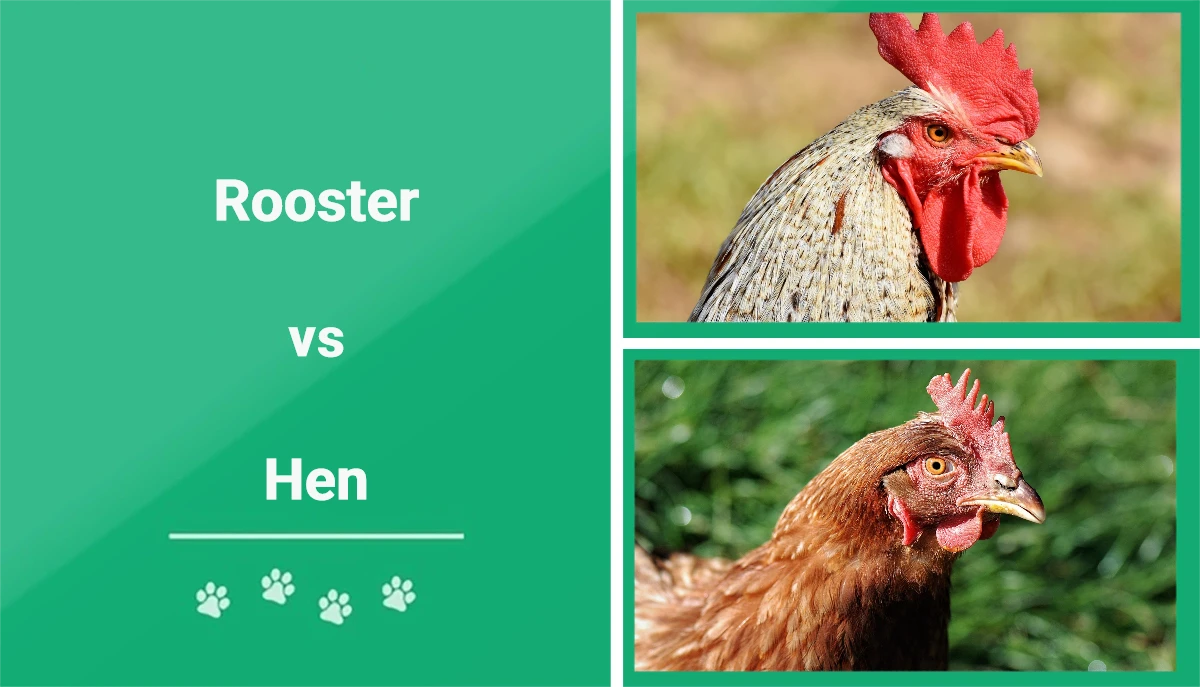Two of the most common birds found on farms across the United States are the rooster and the hen. It’s common to wonder what the difference between these two animals is, and that’s what we are going to help you with right now. Technically, they are both chickens, but keep reading, and we’ll help you learn the exact difference.

Visual Differences

At a Glance
- Average height (adult): 28–32 inches
- Average weight (adult): 9–11 pounds
- Lifespan: 10–15 years
- Exercise: 1+ hours a day
- Family-friendly: Yes
- Other pet-friendly: No
- Trainability: Minimal
- Average height (adult): 25–28 inches
- Average weight (adult): 3–5 pounds
- Lifespan: 5–10 years
- Exercise: 1+ hours a day
- Family-friendly: Yes
- Other pet-friendly: No
- Trainability: Minimal
Rooster Overview

Personality / Character
A rooster is a male chicken. Therefore, you can call it a chicken if you like. Male chickens, or roosters, tend to be much larger than their female counterpart and can stand nearly 3 feet tall and weigh close to 10 pounds. Since breeders don’t breed for temperament, it can vary widely from one rooster to the next. Some roosters can be quite friendly, while others seem to enjoy quarreling. Early socialization can help, but not always. Roosters usually don’t attack other pets, but many dog breeds will chase them.
Health & Care
Roosters will watch over your hens and protect them from predators, but they will need some care from you to stay healthy and live a long life.
Wounds
If your rooster has a hard day protecting the hens, there’s a chance he will get injured. If he gets wounded and starts to bleed, you will need to apply a blood stop powder. Contrary to what you might see on television, you cannot apply bandages to a rooster, but you can temporarily separate him from the flock for his protection. An antiseptic spray can help reduce the risk of infection.

Spurs
Roosters have larger spurs than hens, and it’s an easy way to tell them apart. As the bird ages, these spurs can grow out of control, so you will need to clip them. However, you’ll find it quite difficult to get the rooster to stay still. Wrapping them in a towel can help you manage them while you trim off a small piece and file it down. If a bone spur breaks, you will need to remove it and file it down carefully, so it doesn’t snag.
Toenails
You will also need to file and clip the toenails like the spurs. The towel will help you with this step as well.
Mites
If your rooster becomes infected with mites, you will need to remove them before he transfers them to the hens when breeding. A spray bottle of diluted permethrin can help eliminate the mites and get your rooster ready for mating season.
Frostbite
The rooster’s comb and wattles are more susceptible to frostbite than a hen, resulting in the loss of tips and points. Keep the rooster in a heated coop for the winter months if your area frequently sees temperatures below freezing.
Suitable for:
Roosters are best used on farms to watch over the hens. On occasion, you might find one that is especially friendly that you can keep as a pet. However, the rooster call can be quite disturbing to some people, and if you live in a town or city, there might be rules against it.

Hen Overview

Personality / Character
The chicken is the encompassing term that includes both roosters and hens. Since we already discussed the traits of the rooster, we’ll look closer at the hen. Hens are female chickens, and they tend to be much smaller than the rooster and weigh only half as much. They go into a deep sleep and can be an easy target for predators, which is a good reason to keep a rooster nearby. A hen will often find a high place to roost to stay safe, and will sleep in the same place every night. Hens are very social and will often form a pack of up to 15 birds. In the wild, each flock will have one rooster.
Health & Care
Hens are similar to the rooster in health requirements.
Wounds
You will need to treat wounds the same way you do for a rooster. However, you will need to move much quicker because chickens are cannibals and the hens are all close, so the situation can quickly become a crisis. Remove the chicken from the flock, stop the bleeding, and keep it separated until it heals.
Spurs and Toenails
Hens have much smaller spurs, so you will not need to do much maintenance on them, but the toenails will require occasional maintenance. You can make use of their tendency for deep sleep to sneak up on your chickens a few hours after dark to catch them easily.

Mites
Mites are a major concern with hens because they are close enough to other hens to spread them. You will need to stay vigilant about checking them and eliminating any mites you find by following the method we described earlier.
Frostbite
While not as big a concern for hens as for roosters because they don’t have the large comb, you will still need to protect your hen from extreme weather by providing them with a draft-free coop and supplying heat when necessary.
Suitable for:
Hens often make great pets, and you can usually keep a few in a coop to supply you with eggs year-round. The only thing you need to worry about is that they are social animals, and if you don’t have two or three, it may not be happy, resulting in fewer eggs produced.

Which Is Right for You?
Many people like to keep hens for the eggs to produce. If this is the case for you, we recommend building a large draft-free coop and purchasing 3–10 hens. For better results and happier chickens, buy one rooster to watch over the flock. You will need to spend a little more time choosing your rooster because they have varying personalities, and you don’t want to get one that doesn’t like you or people in general.
We hope you have enjoyed reading this guide and better understand the difference between these two common farm birds. If you think it can help others, please share this guide to the difference between roosters and chickens on Facebook and Twitter.
Featured Image Credit: Top – Ralphs_Fotos, Pixabay | Bottom – HOerwin56, Pixabay

